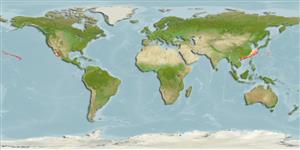Environment: milieu / climate zone / depth range / distribution range
Ecologia
marinhas demersal; intervalo de profundidade 9 - 275 m (Ref. 9335). Deep-water; 30°N - 19°N
Eastern Central Pacific: Hawaiian Islands, off Baja California, and the Revillagigedo Island. Probably more widely distributed.
Tamanho / Peso / Idade
Maturity: Lm ? range ? - ? cm
Max length : 26.0 cm SL macho/indeterminado; (Ref. 5403)
Occur mostly at depths of 100 m or more and has been captured at night at relatively shallow depths (9-46 m). More common around islands (records from the continental coasts are rare) (Ref. 9335). Inhabit rocky bottoms but many specimens have been trawled from relatively open waters in Hawaii (Ref. 5403). Benthopelagic (Ref. 58302). Gonads of specimens collected in Hawaii in November appear to be near spawning condition (Ref. 5403).
Ciclo de vida ou comportamento de acasalamento
Maturidade | Reprodução | Desova | Ovos | Fecundidade | Larvas
Starnes, W.C., 1988. Revision, phylogeny and biogeographic comments on the circumtropical marine percoid fish family Priacanthidae. Bull. Mar. Sci. 43(2):117-203. (Ref. 5403)
Status na Lista Vermelha da UICN (Ref. 130435: Version 2024-1)
Ameaça para os humanos
Harmless
Uso pelos humanos
Pescarias: sem interesse
Ferramentas
Relatórios especiais
Baixar XML
Fontes da internet
Estimates based on models
Preferred temperature (Ref.
123201): 15.5 - 22.6, mean 20.8 °C (based on 12 cells).
Índice de diversidade filogenética (Ref.
82804): PD
50 = 0.5002 [Uniqueness, from 0.5 = low to 2.0 = high].
Bayesian length-weight: a=0.01698 (0.00734 - 0.03932), b=2.91 (2.72 - 3.10), in cm total length, based on LWR estimates for this (Sub)family-body shape (Ref.
93245).
Nível Trófico (Ref.
69278): 4.2 ±0.73 se; based on food items.
Resiliência (Ref.
120179): Elevada, tempo mínimo de duplicação da população menor que 15 meses (Preliminary K or Fecundity.).
Fishing Vulnerability (Ref.
59153): Low vulnerability (22 of 100).
Nutrients (Ref.
124155): Calcium = 43.6 [26.4, 108.4] mg/100g; Iron = 0.639 [0.266, 1.254] mg/100g; Protein = 18.1 [17.1, 19.0] %; Omega3 = 0.44 [0.24, 0.80] g/100g; Selenium = 13.7 [5.9, 29.3] μg/100g; VitaminA = 17.3 [3.8, 76.9] μg/100g; Zinc = 0.403 [0.281, 0.593] mg/100g (wet weight);
